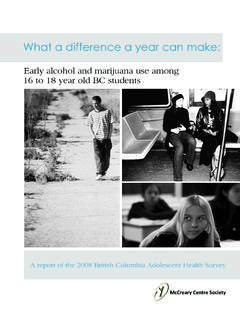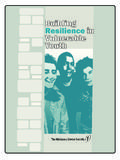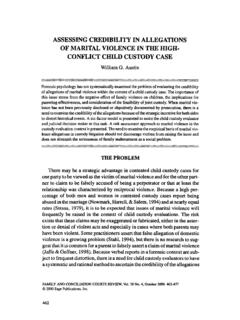Transcription of The McCreary Centre Society
1 The McCreary Centre Society3552 East Hastings St. Vancouver, V5K Out II: A Profile of BC Youth in Custody22222 Project TeamAileen MurphyManaging DirectorMinda ChittendenResearch AssociateSarah HaanstraResearch AssistantJennifer CameronAdministrative AssistantAlison LiebelCommunications CoordinatorLisa MayCommunications ConsultantElizabeth SaewycMethods and Measurement ConsultantAcknowledgementsThank you to Charisse Giarraputo, Youth CustodyServices, Youth Justice Policy and Program Sup-port, Ministry of Children and Family Develop-ment, and Mark Gosse, Executive Director, YouthCustody Services, Ministry of Children and FamilyDevelopment, for their support and appreciates the cooperation of the cus-tody Centre directors and staff.
2 Anita McDonnell, Mark Caros and Corrine Gold-smith at the Burnaby Youth custody Centre ;Blade Tickner, Paige Mashford, and HilaryMcIntyre at the Victoria Youth custody Centre ;and Jim Arnold at the Prince George Youth Cus-tody you to the youth from the Federation ofBC Youth in Care Networks who provided valu-able feedback on the custody survey McCreary Centre Society wishes to acknowl-edge and thank the young people who participatedin the survey. Their willingness to share their lifeexperiences has made this report for the Youth in custody Survey wasprovided by Youth Justice Services, BC Ministryof Children and Family DevelopmentThe views expressed herein do not necessarily represent theofficial policy of the Province of British Citation:Murphy, A.
3 , Chittenden, M., & The McCrearyCentre Society (2005). Time Out II: A Profile of BCYouth in custody . Vancouver, BC. The McCrearyCentre Out II: A Profile of BC Youth in custody waswritten by Lisa May and designed by AlisonLiebel. Cover photo by John McCreary Centre Society33333 Introduction .. 4 Key 6 About the youth custody survey .. 8 The youth justice youth in 13 Physical behaviours ..20 Family and social and community .. 28 Violence and on the youth in higher risk ..43 Recommendations for Centre Society of ContentsTime Out II: A Profile of BC Youth in Custody44444 IntroductionIn Canada, debate about young offenders hasoften focused on two disparate perspectives:professionals and researchers who generallysupport rehabilitation, and public and politicaldemands for harsher punishment.
4 Traditionally,the courts have attempted to strike a balancebetween these two camps, to protect the publicand give youth who commit crimes the oppor-tunity for rehabilitation, healthy development,and a fresh start in legislation governing young offenders, theYouth Criminal Justice Act (YCJA), came into ef-fect on April 1, 2003. While encouraging mod-erate sentences and alternatives toimprisonment for less serious crimes, the legis-lation also changed provisions regarding adultsentences for young people who commit seri-ous, violent number of youth in custody has signifi-cantly declined, from about 400 in 1996/97 to220 in 2002/03, the year before the proclama-tion of the YCJA (2002/03). In the year follow-ing the YCJA, there was a further reduction inthe average number of youth in custody toabout 155.
5 British Columbia has the lowest rateof youth incarceration in Canada. As a result,four of the seven youth custody centres havebeen closed since 2002 and the capacity of twoof the three remaining centres has been re-duced. While fewer youth are detained, thosewho are represent the most troubled youthcommitting the most serious report, Time Out II: A Profile of BC Youth inCustody, presents the findings from a compre-hensive survey of these youth, conducted by theMcCreary Centre Society (MCS), a non-profit,non-government organization, with extensiveexpertise in youth health research. The Ministryof Children and Family Development, whichhas responsibility for youth custody centres inthe province, requested the study to learn moreabout youth in custody and their experiences inthe justice system.
6 In all, 137 young people par-ticipated in the survey, answering questionsabout their health, their families, their behav-iour, their experiences inside and outside thecustody Centre , and their expectations for offenders are often seen as either trou-bled adolescents or irredeemable villains. TimeOut II: A Profile of BC Youth in custody focuseson the experiences of these youth, rather thantheir criminal activities. The goal is to provideinsight into the characteristics of young peoplein s custody centres; who they are and why,rather than what they did wrong. The studyprofiles some of the highest risk youth in ,who place the heaviest demands on judicial,Young offenders are often seen as eithertroubled adolescents or irredeemable villainsThe McCreary Centre Society55555social, health, educational and community serv-ices, although they represent a small proportionof all adolescents in the study does not, however, answer complexquestions central to the debate about appropri-ate treatment for young offenders; questionsabout what influences child and adolescent de-velopment; why some young people break thelaw; how much responsibility individual youth,families, schools and Society bear for addressingthe problem.
7 What the capacity for change isamong youth who commit crimes; and whatworks to help young offenders find a differentpath in report tells an extremely disturbing of the young people surveyed have sur-vived physical or sexual abuse, and grew up infamilies where suicide, addiction and criminalactivities were common. The majority has livedin government care at some time. Most haveongoing physical and mental health problems,and began using drugs and alcohol at an earlyage. Many of these young people are lonely anddisconnected from their families and communi-ties. Some have felt angry or hopeless enough tothink about, or try, taking their own lives. Mostof these youth have committed violent of-fences, and been incarcerated more than transcend their past and thrive in adult life,Youth in custody haveoptimistic aspirations for abetter futureyoung people in custody must overcome enor-mous obstacles.
8 Despite the difficulties theyface, this survey shows that youth in custodyhave optimistic aspirations for a better fact, most youth in custody want to attain thesame goals in life that others want: a future thatincludes education, jobs, family and a home oftheir youth will have to work hard to createconstructive change in their lives and make theirdreams come true. So will the systems thatserve them. Research has shown that health isaffected by broader social determinants, in-cluding employment opportunities, income,social supports, environment and early child-hood development. Progressive governmentpolicies, social services and educational oppor-tunities can improve these determinants ofhealth, and help youth in custody develophealthier personal practices, coping skills, andsupport networks, factors that help protectyouth from risk and provide McCreary Centre Society hopes the infor-mation in this report will be helpful to thoseresponsible for the well being of youth in thejustice system, the families of these youth, andthe young people themselves, as they strive todevelop skills, surmount challenges, and achievetheir Out II.
9 A Profile of BC Youth in Custody66666 Key FindingsTroubled livesThe second survey of youth in custodycentres shows that most young people whocommit serious crimes have experienced trou-bled, chaotic lives, with many obstacles imped-ing their healthy development. Most of theseyouth have engaged in risky behaviours, andbecame involved in criminal activities at a youngage. Most have bullied or picked on others, andbeen in custody more than once. Compared toother youth in , youth in custody are muchmore likely to have: A serious physical or mental health condi-tion or disability, including Attention Defi-cit/Hyperactivity Disorder, addictions,learning disabilities, depression, Fetal Alco-hol Syndrome, bipolar disorder or schizo-phrenia.
10 Less connection with their families andschool, and fewer social supports. Parents or other family members with ahistory of substance use, mental healthproblems and criminal activities. Been physically abused, most often by aparent. Considered or attempted suicide. A family member who attempted or com-mitted suicide, or has died in an accident, orfrom an overdose or violence. Lived in government care, in a foster orgroup home. Experienced severe emotional distress. Smoked, drank alcohol and used drugs. Been sexually active, starting at a youngerage. Contracted a sexually transmitted infection(STI), been pregnant, or gotten someonepregnant. Been expelled or suspended from school. Carried weapons and been in fights.












